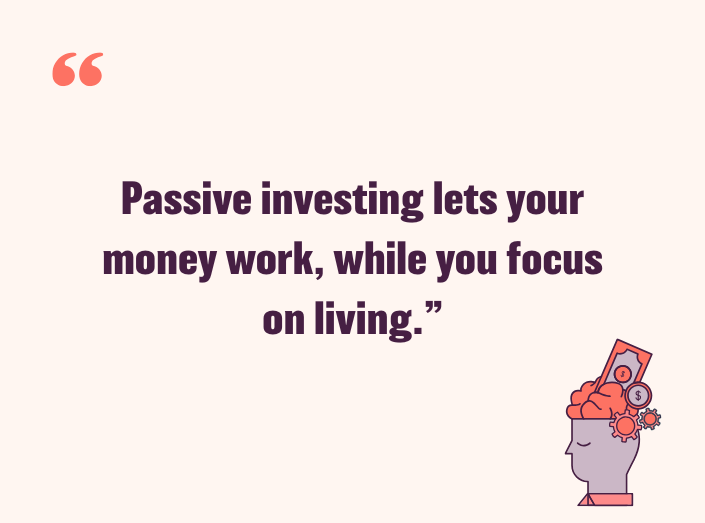Let’s be honest, investing shouldn’t feel like a full-time job
If the thought of picking stocks, timing the market, or watching your investments every day makes you anxious, you’re not alone. Many people want to grow their money, but without spending hours glued to financial news or juggling trades.
That’s exactly where a passive investment portfolio strategy comes in.
It’s simple. It’s low maintenance. And it’s backed by decades of evidence showing that slow and steady really can win the race.
Whether you're new to investing or just tired of overcomplicating things, this guide will walk you through how to build a passive investment portfolio that works in the background while you get on with your life.

So, what is a passive investment strategy?
A passive investment strategy means choosing investments that follow the market rather than trying to beat it. Instead of constantly buying and selling, you pick a mix of assets, usually through index funds or ETFs, and leave them to grow over time.
You don’t need to check prices every day. You don’t need to react to every headline. You simply stay consistent, let the market do its thing, and avoid the emotional rollercoaster that often leads to poor decisions.
It’s about being patient, not passive in the careless sense, just passive in the smart, steady one.
Why passive investing works
Markets go up and down. That’s normal. But over time, they’ve historically trended upwards. Passive investors take advantage of this long-term growth without trying to outguess it.
When you invest passively, you’re not betting on a single company or timing your trades. You’re investing in broad market exposure, like the FTSE 100, the S&P 500, or global stock indices, and trusting that staying in the market beats trying to outsmart it.
And here’s the kicker: most active investors don’t beat the market long term. Even many professionals fall short after fees are taken into account.
Passive investing skips the stress and the cost, and often delivers better results.

What goes into a passive investment portfolio strategy?
A good passive portfolio usually includes a small number of diversified, low-cost funds that cover different parts of the market.
Most portfolios start with a core holding like a global equity fund or an all-world index fund. From there, you might add some bonds for stability, or sprinkle in specific regions or sectors if you want a bit more control.
The trick is not to overload it. You don’t need 20 funds to be diversified. Often, just two or three well-chosen ones are enough.
Once you’ve built your portfolio, your job is simple: keep adding to it regularly, ignore the noise, and rebalance now and then to maintain your target mix.
The benefits of a passive strategy
Passive investing isn’t just easy, it’s powerful. Here’s why so many people are making the switch:
- Lower fees – Index funds and ETFs usually cost far less than actively managed funds
- Less stress – No need to chase trends or watch the market daily
- Better consistency – Sticking to a plan beats jumping in and out based on emotions
- Fewer mistakes – Passive strategies reduce the chance of panic selling or buying too high
- Proven performance – History shows that long-term, low-cost investing tends to win
It’s not about doing nothing, it’s about doing the right things, consistently.

Who is passive investing for?
This strategy is ideal for:
- People who want to invest long term
- Anyone too busy (or uninterested) to monitor markets constantly
- Beginners looking for a safe, simple starting point
- Savers who value peace of mind as much as performance
- Investors who want to focus on life, not finance
You don’t need to be rich to start. You just need to get started.
Getting started with a passive portfolio
Begin by deciding how much risk you're comfortable with. That helps determine your mix between equities (for growth) and bonds (for stability).
Then, choose a reliable platform or app that offers low-cost index funds or ETFs. Many now offer pre-built portfolios based on your preferences, so you don’t have to pick each fund yourself.
Set up a monthly investment amount. Automate it. And let time do the work.
Check in once or twice a year. Rebalance if things drift too far from your target. Most importantly, resist the urge to tinker too much.

Final thoughts: less effort, more impact
A passive investment portfolio strategy might not sound glamorous, but that’s exactly the point. It’s calm, reliable, and proven to work over time.
Instead of reacting to every market blip, you stay focused on your long-term goals. You build wealth in the background. And you get to enjoy life without the stress of day-to-day decision-making.
Start your passive investing journey today
Download our free app and build a fully diversified passive portfolio in just minutes.
No guesswork. No pressure. Just smart tools, low fees, and a clear plan designed around your goals. Whether you're saving for retirement, a home, or long-term security,we’ve got you covered.
👉 Download the app now and invest with confidence, the passive way
Simple investing. Strong results. Less stress.
-
Advice vs. guidance
If you’re new to the world of investments, you could well be worried about how much it costs to get started. The short answer is: ...
